El Salvador
Country statistics
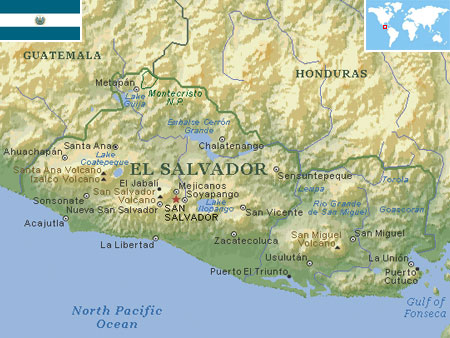
Land area: 8,000 sq miles (20,720 sq km)
Total area: 8,124 sq miles (21,040 sq km)
Population (2010 est.): 6,052,064 (growth rate: 0.3%); birth rate: 18.06/1000; infant mortality rate: 20.9/1000; life expectancy: 73.2; density per sq km: 341
Capital City: San Salvador
Monetary unit: Colón; U.S. dollar
Languages: Spanish, Nahua (among some Amerindians)
Ethnicity/race: mestizo 90%, white 9%, Amerindian 1%
Religions: Catholics 83%; growing population of evangelical Protestants (1992)
Country introduction
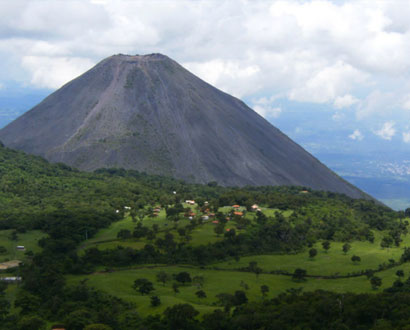
El Salvador is the smallest and the most densely populated country in Central America. The country borders the Pacific Ocean on the south, Guatemala to the west and Honduras to the north and east. Its eastern-most region lies on the coast of the Gulf of Fonseca, opposite Nicaragua.
El Salvador, along with the rest of Central America (a region comprising mainly of Mexico and Central America), is one of the most seismologically active regions on Earth, situated atop three of the large tectonic plates that constitute the Earth's surface. The motion of these plates causes the area's earthquake and volcanic activity. Most of El Salvador is volcanic uplands, which run two almost parallel volcanic ranges. The highest volcanoes are Santa Ana at 2,365 m (7,759 ft), San Vicente at 2,182 m (7,159 ft) and San Salvador at 1,943 m (6,375 ft). Volcanic activity has resulted in a thick layer of ash and lava on the highlands, creating a richly mineralised soil, ideal for coffee planting. Lowlands lie to the north and south of the high backbone. The highest point in the country is Cerro El Pital, at 2,730 m (8,957 ft), on the border with Honduras.
On the country's longest river, the Rio Lempa, the 800 m (2624 ft) wide hydroelectric Cerrón Grande Dam provides power to much of the country. Fed by rivers in Guatemala and Honduras, the Lempa flows in a broadly southern direction spreading into the Bajo Lempa flood plain before draining into the Pacific.
Lago De Ilopango is the country's largest natural lake with a surface area of 72 sq km (28 sq miles). A scenic crater lake with steeply scalloped banks, it lies just to the east of San Salvador. Of the country's other lakes, Lago De Coatepeque is the most notable and perhaps most scenic with hot springs an added attraction for visitors. The lake covers 26 sq km (10 sq miles) in the province of Santa Ana, and like Ilopango it has steep high banks. Rising up from Coatepeque's watery blue crater is Isla Teopán ('prouting island') where important Mayan artefacts have been found.
The culture
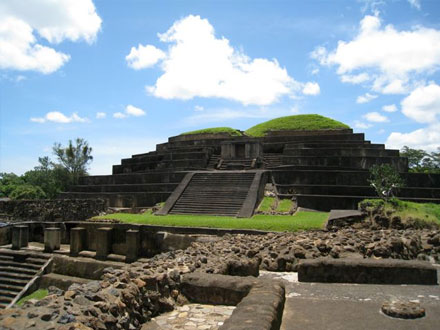
El Salvador reflects an amalgamation of an ancestral culture with a Mayan Spanish influence. The result is a colorful array of colonial charm that provides a beautiful cultural heritage for its descendants.
Music in El Salvador forms a major part of the culture of El Salvador. Common music in the country uses instruments like drums, flutes, guitars, marimba tehpe'ch, scrapers and gourds. One of the finest dances is the torito pinto. Normally it is danced in pairs and the choreography can have different interpretation and it can also be accompanied by folk music. Poetry is popular in El Salvador. Some of the most recognized poetry authors include Roque Dalton, Francisco Rodriguez, and Manlio Argueta. Other infamous writers in El Salvador include Salvador Salazar Arrue, Alfredo Espino, Francisco Gavidia, Pedro Geoffroy, and Claudia Lars.
Arts and crafts are also popular forms of culture of El Salvador, whether in the creation of articles prepared of bamboo, wood, clay, textiles, or ceramics. The tribal areas and the local villages are wonderful centers for beautiful handicrafts and local artifacts. The village of San Sebastian is celebrated for its textile arts, while Ilobasco is recognized for its ceramics. The village of La Palma is presently renowned for a school of art originating from Fernando Llort. Llort is unique in creating childlike images of mountain villages, Christ, and campesinos, which are similar to cartoons. He utilizes bright colors to paint these images on substances varying from seeds to church walls. Ceramics, painting, and textile articles are the primary labor-intensive artistic expressions. Francisco Wenceslao Cisneros is one of the recognized painters. In 1980, the Asociación de Artistas Plásticos de El Salvador was founded by a known group of Salvadoran artists.
Traditional Salvadoran cuisine joins the fare of the American Indians and Spain. Much of the food from El Salvador is made with maize. The most popular food item is pupusas, small cornmeal pancakes stuffed with meat, beans, or cheese. This popular traditional cuisine can be found at nearly any food stand around the country. Another popular dish is sopa de pata, a soup whose base is cow's feet. For desert, people enjoy Dulce de Leche, a caramel candy with milk. The dulce de leche is not similar to what the majority of Americans are accustomed to as it has a soft, crumbly texture. The most common fruits include papayas, mangoes, and bananas.
Football is the most popular sport in the country. Some notable football stadiums in the country are Estadio Cuscatlán (San Salvador), Estadio Jorge Calero Suarez, Estadio Luis Amílcar Moreno, Estadio Simeón Magaña, Estadio Oscar Quiteño, and the the Sergio Torres Stadium. Other sports in the country are volleyball, swimming handball, and basketball.
The Holidays of El Salvador include religious holidays as well as social and cultural holidays. Because the population is mostly Catholic all the usual Christian holidays are observed including Easter and Christmas. Other holidays include the Peace Accords Day on January 16, which is observed to mark the signing of the peace accords between the government and the guerrilla troops in the year 1992 to end the civil war. The busiest and most eagerly celebrated holiday is the El Salvador del Mundo, the patron saint of San Salvador, which is celebrated between 1st and 7th August. The festival is more a carnival than a religious ceremony, transforming busy streets with floats, dancers and exuberant color. Other festivals in August include the Fiestas Agostinas and Balls of Fire Festival. A religious holiday, the Day of the Dead is marked on November 2 for people to visit the tombs of the relatives and the deceased to pay their respects.
Attractions & landmarks
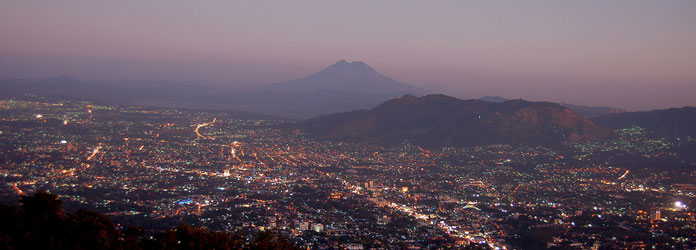
El Salvador is a beautiful country with many natural beauties, cultural, material and immaterial. Its name in the indigenous Cuscatlán language, means "land of jewels", Jewels that visitors to this country will find.
San Salvador, the capital of the country, is an old city settled in a valley next to Quezaltepec, a volcano that is considered an icon of the city. The volcano at a height of 1,960 m (6,430 ft) last erupted on 6 June 1917 destroying most of the city, and despite there being a potential for it to erupt again, the city is adjacent to the volcano with even the western section lying among its slopes. The city houses many great attractions and one of the most visited is the Metropolitan Cathedral. This very old church sits on the same site as the old Temple of Santa Domingo and is the main church of the Roman Catholics in San Salvador. It is also the burial place of Oscar Romero, a bishop with the Roman Catholic Church, who was assassinated in 1980. Nearby, the red-velvet opulence of the Teatro Nacional dates from 1917. Its sensuous ceiling mural is continued into the nearby Teatro Cafe. The city has two markets, the Mercado Ex-Cuartel for handicrafts, handwoven textiles and ceramics, and the Mercado Central for daily needs. Other landmarks include the Museo Nacional David J. Guzman, which holds most of the country's notable archaeological finds, and the Jardin Botanico La Laguna, an attractive garden built on what was once a swamp at the bottom of a volcanic crater.
The most interesting landmarks in El Salvador are the numerous ruins of prehistoric cities scattered all over the country. The most important archaeological site is the ancient Mayan city of Tazumal, located about 60 km (37 miles) west of the capital San Salvador. There are many Mayan structures and artifacts that can be observed there including pyramids that rise some 22 m (75 ft) high, tombs and a complex drainage system. Also located in the same area are the Casa Blanca ruins which are the remains of a very large Pre-Classic (500 BC - AD 250) and Classic period (AD 250-900) settlement. The site possesses several pyramids with only two partially restored. The tallest pyramid rises approximately 15 m (49 ft) while the ones that are still buried allow visitors to only see the bulges or swellings on the ground. Joya de Cerén is another popular Mayan ruin site located 42 km (26 miles) west from San Salvador. The archaeological site was a farming village that had been preserved remarkably intact after it was destroyed by the eruption of the nearby Loma volcano around 600 AD. Because of the high level of preservation from the volcanic ash, the site offers insight into the agricultural based village that once existed there. It is often referred to as the "Pompeii of the Americas", in comparison to the famed Ancient Roman ruins.
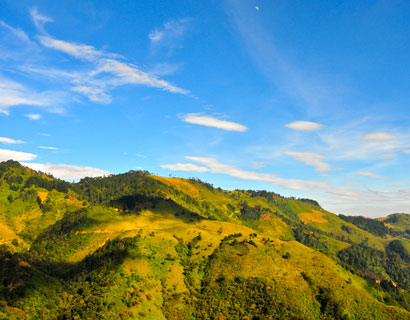
Montecristo National Park, located 125 km (77 miles) north-west of San Salvador near the border of Guatemala and Honduras is a very popular destination for the adventurous travelers. The park is a vast rainforest that includes three important mountains, Montecristo, Miramundo and El Brujo, at 2,418 m (7,933 ft) above sea level. The park offers camping areas, a botanical garden, and rustic pathways which take visitors far into the humid forest. One of its main attractions is the trees which can reach up to 30 m (98 ft) high, like the cypresses, oaks and pines. The Garden of the Hundred Years (Jardín de los Cien Años) holds an incredible exhibit of orchids.
Located on Central America's Pacific Coast, the El Salvador beaches are home to some of Latin America's finest surf breaks. The coastline is lined with villages both lively and tranquil with warm waters perfect for swimming as well as surfing. The most well known include El Tunco, El Zonte, El Zunsal and La Libertad.